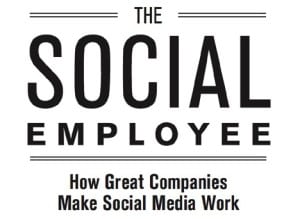 We still hear it often from attendees at PR News' live events and webinars—senior leaders at many organizations dread, fear and dismiss the positive value of social media in general and the social media engagement of their employees specifically. Never mind the intense pressure on communicators to prove the business value of company-sanctioned social media efforts.
We still hear it often from attendees at PR News' live events and webinars—senior leaders at many organizations dread, fear and dismiss the positive value of social media in general and the social media engagement of their employees specifically. Never mind the intense pressure on communicators to prove the business value of company-sanctioned social media efforts.
If you need case study examples to prove the competitive value of a "social" culture, check with Mark Burgess, co-author (with Cheryl Burgess) of “The Social Employee: How Great Companies Make Social Media Work," co-founder and president of Blue Focus Marketing and keynote speaker at PR News' Sept. 16 Platinum PR Awards luncheon in New York City. His point of view is similar to that of Brian Solis—if your internal culture can't keep up with the technology-driven changes in the external culture, your organization is in trouble.
Here's a preview of Burgess' Platinum PR Awards keynote presentation:
PR News: How does what you call a "social employee" differ from an employee who may use social media but it isn’t part of their job officially?
Mark Burgess: Social employees are engaged, passionate and true believers in a company's mission, vision and values, and strong brand ambassadors. They buy in to an organization's social media policy and are highly skilled in the use of social media tools. A social employee is an organization's most valuable business asset. We like to say that they hide in plain sight. Many are already familiar with the use of social tools and have multiple social media accounts. They see Twitter, blogs, Facebook, etc., as pragmatic solutions to the challenges that confront them. Social media becomes a solution for streamlining communications across the organization and with customers and prospects.
PR News: What does an organization stand to gain by developing a "social culture"?
Burgess: We have heard the saying: culture eats strategy for breakfast. By creating a social culture, an organization will achieve several benefits. In "The Social Employee," we highlight success stories and innovative methods that several leading brands including IBM, AT&T, Dell, Adobe, Cisco and Southwest have employed to foster cultures of enthusiastic and engaged workers. Here are a few of the key benefits to the organization: 1) create brand ambassadors 2) humanize your brand in a social world 3) solution to shrinking marketing dollars 4) generate leads and sales 5) retain your high-value employees 6) build stronger/deeper relationships with customers 7) generate trust and authenticity 8) gain competitive advantage.
PR News: How can PR professionals lead a shift in culture at their organizations and make them more social?
Burgess: They lead by example. They must operate in the evolving world of social business. There is a significant opportunity for PR professionals to become “social leaders” within their organization. A social leader can be compared to a player-coach on a football field who not only calls the plays for their team but also participates on the field. They are players. They are in the game. They are active and visible social ambassadors for their brand. Like the employees, they become the voice of the brand. And, 82% of respondents in a 2012 Brandfog survey were more likely to trust a brand whose executives were involved in social media.
PR News: In terms of their own careers, what do PR pros stand to gain by becoming social leaders?
Burgess: It’s a win-win for companies and PR pros to use social tools because its helps employees build their personal brand. This allows social employees to distinguish themselves in a sometimes crowded and always competitive job market.
Mark Burgess, author of “The Social Employee: How Great Companies Make Social Media Work," will keynote PR News' Platinum PR Awards luncheon on Sept. 16, 2014, at the Grand Hyatt in NYC. See the list of finalists and registration information.
Follow Steve Goldstein: @SGoldsteinAI
